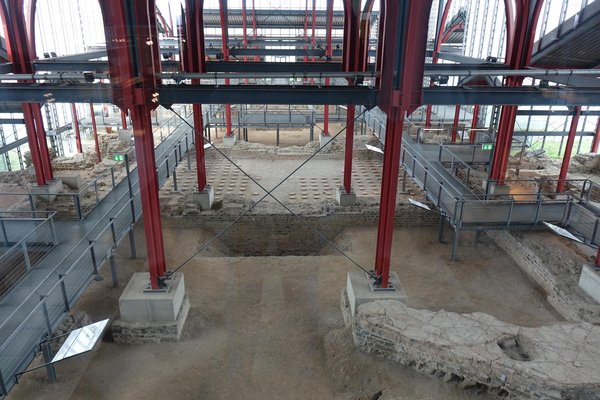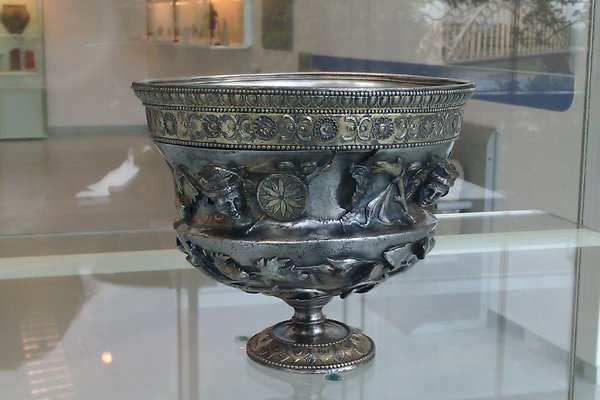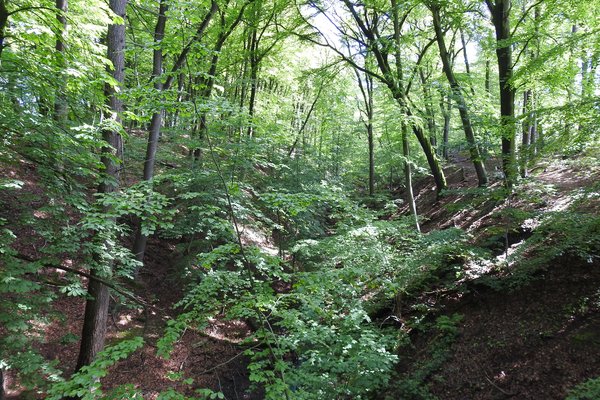Germany, Netherlands
Lower German Limes
The Lower German Limes formed the north-eastern border of the Roman province Germania Inferior along the Rhine between the North Sea coast in the Netherlands and the Rhine south of Bonn where the Upper Germanic-Rhaetian Limes starts.
They include the traces of military fortifications, roads, settlements, an aqueduct and canals, often now buried in wetland. The long linear frontier made the Roman army adapt to the use of smaller military installations instead of big operational bases. The frontier was far from impregnable and allowed for trade and cultural exchange.
Community Perspective: Most of the structures only have been preserved underground. Original remains are visible at the Archaeological Park Xanten (“Roman Disneyland”: “It's a bit strange to reconstruct a temple as a ruin, isn't it?”), the Haus Bürgel in Monheim, the Cologne Praetorium, and in Iversheim. In the Netherlands, you can visit some remains under the Dom Square in Utrecht.
Site Info
Official Information
- Full Name
- Frontiers of the Roman Empire – The Lower German Limes (ID: 1631)
- Countries
- Germany Netherlands
- Status
-
Inscribed 2021
Site history
History of Lower German Limes
- 2021: Inscribed
- Inscribed
- 2018: Revision
- Renominated under the same name but with a different id
- 2018: Revision
- Renomination as part of transnational site with Germany
- 2011: Revision
- Includes former TWHS Bunnik - Vechten / De Burg (1995) and Voorburg - Park Arentsburg / Forum Hadriani (1995)
- Type
- Cultural
- Criteria
- ii
- iii
- iv
Links
- UNESCO
- whc.unesco.org
- Official
-
- limeswerelderfgoed.nl — Limes werelderfgoed (NL)
All Links
UNESCO.org
- whc.unesco.org — whc.unesco.org/
Official Website
- limeswerelderfgoed.nl — Limes werelderfgoed (NL)
Community Information
- Community Category
- Archaeological site: Ancient Rome
Travel Information
Exact locations inscribed twice (or more)
The components "Bunnik-Vechten | Marsdijk" and "Bunnik-Vechten | Provincialeweg" are also part of the …
Serial Transnational Sites
Amsterdam hotspot
North Rhine-Westphalia hotspot
Recent Connections
-
Perfect Inscriptions
2021 -
Shipwrecks
"The more than thirty shipwrecks preser… -
North Sea
"The fort at Valkenburg-Centrum was bu…
Connections of Lower German Limes
- Individual People
-
-
Emperor Trajan
"When Nerva died this adoptive son, the able general M. Ulpius Traianus (AD 98–117), was residing in the praetorium at Köln as acting governor of Lower Germany. Trajan's first actions as emperor included the foundation of the Colonia Ulpia Traiana at Xanten and the promotion of the civil settlement at Nijmegen to Ulpia Noviomagus, probably as early as AD 98 or 99." (Nomination file, p. 83-84) -
Emperor Hadrian
Emperor Hadrian created the Municipium Aelium Cananefatium or Forum Hadriani at Voorburg. (Nomination file, p. 48) He visited the Lower German Limes in 121/122, before crossing over to Britannia.See nl.wikipedia.org
-
- Geography
-
-
North Sea
"The fort at Valkenburg-Centrum was built on the western bank of the Roman Rhine, close to its estuary, immediately bordering the river channel." (Nomination file, p. 60) - Corbulo's canal: "The historian Tacitus records that the canal was constructed to provide a connection between the estuaries of the two rivers, as a safe inland alternative to the route along the North Sea coast." (Nomination file, p. 104) -
Rhine
"Following the left bank of the Lower Rhine River" (AB ev) -
Estuary
"The fort at Valkenburg-Centrum was built on the western bank of the Roman Rhine, close to its estuary, immediately bordering the river channel." (Nomination file, p. 60) At Valkenburg-De Woerd, the "characteristic ribbon-like layout of a military vicus is combined (...) with measures taken to deal with the wet landscape of a river estuary." (Nomination file, p. 104) -
River deltas
"The Lower German frontier was established in the very distinctive landscape of a lowland river and its delta. (...) The tight network of military installations of the Lower German Limes (...) continued throughout the delta, with a screen of posts in vulnerable positions on the river bank." (Nomination file, p. 101) The fort at Valkenburg-Centrum is the "best known example of the 'delta type'". (Nomination file, p. 104) -
Linear inscriptions
"The Lower German Limes was the earliest linear frontier of the Roman Empire" – "The component parts of the serial property have been selected to represent the linearity and attributes of the Frontier, demonstrating the early development of the perimeter defence." (Official description)
-
- Trivia
-
-
Underground Boundaries
Most of the sites are buried, with possible reconstructions above ground not included in the core zone. -
Discovered from the Air
Kleve-Keeken (20): "The camp was first discovered in 2016 by aerial photography." (Nomination file, p. 68) -
Serial sites with the greatest number of locations
51 -
Tour de France
Tour de France 2015, Stage 2 (Dom Square in Utrecht)
-
- History
-
-
Limes
-
Buried treasures
Remagen: According to the ceramic finds, the fort lasted well beyond the middle of the third century. The discovery of a hoard not far from the Porta Praetoria should also be seen in this context. The depot contained 8,500 coins, all Antoniniane made of silver-plated bronze, which were minted near Remagen as emergency money between 270 and 280 and were only in circulation for a short time. The creation of the hoard is probably related to the devastation of the Rhineland by the Franks. (wiki)See de.wikipedia.org
-
Mentioned by Pliny the Elder
Gelduba (Krefeld-Gellep) is mentioned in Pliny's Naturalis historiaSee de.wikipedia.org
-
Sieges and Battles
Krefeld-Gellep: "Gelduba is also a battlefield site associated with the Batavian revolt. Parts of the battlefield with unique archaeological features are located under the fort or in the immediate vicinity. They tell the story of the attack by the Batavians on the camp of the Governor Caius Dillius Vocula."" (Nomination file, p. 72) -
Ancient Roman colonies
Cologne was promoted to a "colonia" by Emperor Claudius in AD 50. (Nomination file, p. 48) - Colonia Ulpia Traiana (Xanten) was elevated to a Roman colony by Emperor Trajan around 100 AD. (wiki)See de.wikipedia.org
-
Historical Food Remains
The "layered rubbish deposits constitute veritable treasure-chests of everyday life on the frontier. Well-preserved animal bones, seeds and pollen permit the reconstruction of the surrounding landscape, the diets of men and animals, and the sources of supply with animal and plant food." (Nomination file, p. 50)
-
- Architecture
-
-
Early Under-floor Heating
Hypocausts were found in some rooms of residential buildings and villas in Colonia Ulpia Traiana (Xanten).See de.wikipedia.org
-
Wooden architecture
"Thanks to the outstanding preservation of organic remains and to the repeated rebuilding of vulnerable forts, Frontiers of the Roman Empire – The Lower German Limes constitutes a showcase of Roman construction in timber. (...) The fort of Valkenburg-Centrum is internationally renowned for its standing timber remains, but the nomination includes several sites with similar preservation conditions." (Nomination file, p. 44)
-
- World Heritage Process
-
-
Exact locations inscribed twice (or more)
The components "Bunnik-Vechten | Marsdijk" and "Bunnik-Vechten | Provincialeweg" are also part of the Dutch Water Defence Lines. At the parking lot of Restaurant Vroeg you're in both WHS.
-
Derived from more than one TWHS
Includes former Dutch TWHS Bunnik - Vechten / De Burg (1995) and Voorburg - Park Arentsburg / Forum Hadriani (1995) -
Perfect Inscriptions
2021 -
Serial Transnational Sites
2 countries
-
- Religion and Belief
-
-
Mithraism
Consecration stones for Mithras have been found in Dormagen (Durnomagus).See de.wikipedia.org
-
Hercules
Elst-Grote Kerk: "The monumentality of the temple at Elst-Grote Kerk suggests that the Roman army was involved in its construction. The main deity assumed to have been venerated here, Hercules Magusanus, appears to have been especially popular among soldiers and veterans." (Nomination file, p. 65)
-
- Human Activity
-
-
Shipwrecks
"The more than thirty shipwrecks preserved in the Rhine channel constitute another valuable source of timber construction technology." – "The component parts of Frontiers of the Roman Empire – The Lower German Limes include remains of at least two ships: a patrol craft at Bunnik-Vechten and a cargo ship at Utrecht-Balije". (Nomination file, p. 45, 59) -
Piracy
"the very specific bank edge siting of these forts was an absolute requirement for the fulfilment of their primary task: the observation and protection of river traffic. Most were built in AD 40 or soon after, a period for which we have indications of Germanic piracy." (Nomination file, p. 44) -
River Ports
"The irregularly shaped fort of Köln-Alteburg has been identified as the main base of the Roman fleet on the Rhine (...). As the fort is located on the river terrace, c. 8 m above the water level of the Rhine, the harbour installations must have been located along the river channel, but so far no remains of it have been attested." (Nomination file, p. 54)
-
- Constructions
-
-
Protective Shelters
A protective structure was built over the foundation walls of the thermal baths of Colonia Ulpia Traiana (Xanten), which imitates the ancient shape of the building and has housed the Roman Museum since 2008. (wiki)See de.wikipedia.org
-
Aqueduct
Amongst the archaeological remains are .. an aqueduct.. (AB ev) (at Berg en Dal) -
Cemeteries
Amongst the archaeological remains are .. cemeteries .. (AB ev) -
Canals
Corbulo's Canal "The second canal has been firmly attested by archaeological excavation. It was built to connect the Rhine to the river Meuse further south, just behind the coastal barriers, to avoid the risks of a passage by sea. Its course has been recorded over a distance of at least 11 km ...Roman canals are extremely rare, and this excellently preserved example is a vivid illustration of the pains taken by the Roman army to improve the infrastructure of the river delta." (Nom file). -
Baths
The large thermal baths of Colonia Ulpia Traiana occupy an entire insula. They were examined in emergency excavations in 1957 and then buried. After the Archaeological Park was founded, it was exposed again with subsequent conservation. A protective structure was built over the foundation walls of the thermal baths, which imitates the ancient shape of the building and has housed the Roman Museum since 2008. (wiki)See de.wikipedia.org
-
Frontier walls
The defensive ditches and stone walls of the military forts are a testimony of the protection these places of border security needed at the frontier of the Roman Empire. -
Historic Military Parade Grounds
Xanten-Fürstenberg: "In addition to the two double-legionary fortresses, there are at least two large parade grounds within the property, (so-called campi, which offered the legionaries space for training and marching)". (Nomination file, p. 71) -
Horse Stables
Dormagen: "The fort of Durnomagus provides important evidence for the understanding of cavalry forts: it was here that for the first time, stable pits for horses were attested inside barracks through archaeological excavations. This key feature is essential for understanding the daily life of Roman cavalry soldiers." (Nomination file, p. 107) -
Roman amphitheatres
"Archaeological remains in the property include (...) an amphitheatre" (Official description) – At Xanten, an "amphitheatre has been known for much longer here, and amphitheatres are known from extramural settlements elsewhere." (Nomination file, p. 55) -
Necropolises
Gelduba (Krefeld-Gellep): The settlement area became particularly famous for its necropolis, of which over 6,000 graves were archaeologically examined. The period of occupation of the burial grounds ranges from the first to the eighth century and thus has one of the rare continuity of settlements from the Roman to the Merovingian times. (wiki)See de.wikipedia.org
-
- Timeline
-
-
Built in the 1st century
marked the edge of Lower Germany from the 1st to 5th centuries CE (AB ev)
-
- WHS Hotspots
-
-
Amsterdam hotspot
All Dutch locations can be reached from Amsterdam - one of the closest is Arentsburg (Forum Hadriani) near The Hague, the most worthwhile is Valkhof in Nijmegen -
North Rhine-Westphalia hotspot
Xanten (among others)
-
- Science and Technology
-
-
Uncovered using Lidar
Kleve-Reichswald (21): "Traces of a 7 m-wide road embankment have been recorded by LiDAR." (Nomination file, p. 68) – "Through the systematic analysis of LiDAR data, many new temporary camps have been discovered in forest areas near Xanten and Bonn". (Nomination file, p. 91) -
Early Archaeology
"Lithography showing the first scientific excavation (1827–1834) at Voorburg-Arentsburg (Forum Hadriani)" (Nomination file, p. 48) – "Reuvens is famous for his excavations at the former estate of Arentsburg at Voorburg, where he lived in 1827–1834. Here, he uncovered parts of the Roman town of Forum Hadriani, recording his findings in excellent drawings and plans." (Nomination file, p. 88) – In 1820, "the first excavations in the area of the legionary fortress in Bonn took place." (Nomination file, p. 89) Between 1819 and 1844 Philipp Houben, who stood on the threshold between antique collecting and scientific archaeology, carried out extensive excavations in the area of the legionary camps, the CUT and the burial grounds at his own expense. (wiki)See de.wikipedia.org
-
Archaeological potential
"In some cases the buffer zones include areas of archaeological potential" (AB Ev) – Several components include unexcavated sections, e.g. Valkenburg-Centrum, Leiden-Roomburg, Woerden-Centrum, Utrecht-Domplein, Nijmegen-Valkhof area, Nijmegen-Hunerberg, Nijmegen-Kops Plateau. (Nomination file, p. 60, 62, 66, 104, 105) -
Recently discovered
Kleve-Keeken (20): "The camp was first discovered in 2016 by aerial photography." (Nomination file, p. 68) -
Scientific Developments
"Constantin Koenen began excavating the legionary fortress at Neuss in 1887 (...). Constantin Koenen was the first to establish the principles of archaeological research based on excavations. The most modern methods were used, including the first photo documentation of the excavation process. This research represents the beginning of modern provincial Roman archaeology." (Nomination file, p. 89-90) -
Experimental Archaeology
"The LVR-Archaeological Park Xanten (...) was created in 1973 to protect the remains of the Roman town, which were threatened by quarrying and industrial development. (...). The park visualises the scale and outward appearance of a Roman town in a part of the Empire which has only very few aboveground remains of Roman buildings. It increasingly serves as a laboratory for Roman construction techniques, providing many new insights through a process of experimental archaeology, learning-by-doing." (Nomination file, p. 118)
-
- WHS Names
-
-
Roman Province in its official title
Germania Inferior or Lower Germania
-
News
No news.
Recent Visitors
Visitors of Lower German Limes
- Adrian
- Adrian Turtschi
- Alexander Lehmann
- Alex Baranda
- A. Mehmet Haksever
- Ana Lozano
- Anne
- Antonio J.
- Argo
- Ask Gudmundsen
- Aspasia
- Astraftis
- Atila Ege
- Avery MC
- awestix
- AYB
- Badwater
- basementonline
- BaziFettehenne
- Bernard Joseph Esposo Guerrero
- Bin
- BobSmithseestheworld
- Bram de Bruin
- Brendan Carroll
- Can SARICA
- Caspar
- Cezar Grozavu
- Chantal den Haan
- chenboada
- Cheryl
- ChrisDorn
- christof
- Christoph
- Christravelblog
- Claire Bradshaw
- Clyde
- Colossus
- Coppi
- crilly
- Csaba Nováczky
- CugelVance
- Damientournay
- Dani Cyr
- Daniel Chazad
- Daniel R-F
- David Aaronson
- David Berlanda
- DavidS
- Digits
- Dimitar Krastev
- Dolemite92
- Dwight Zehuan Xiao
- Echwel
- Elis
- Els Slots
- Enid MC
- Erik G
- Erik Jelinek
- Errol Neo
- Evgenii
- Farinelli
- Feldhase
- Femke Roos
- FK
- Flexiear
- FrankW
- Frederik Dawson
- FS
- George Gdanski
- GeorgeIng61
- GerhardM
- Hammeel
- Harald T.
- Harry Mitsidis
- Helios
- henrik_hannfors
- heywhatever2
- Hubert
- Ian Cade
- Ingrid
- Ivan
- Ivan Rucek
- Jakob F.
- James Bowyer
- Jana and Matt
- Janina Lehmann
- Jan-Willem
- Jan Zimmermann
- Jarek Pokrzywnicki
- Jasam
- Javier Coro
- Jawnbeary
- Jay T
- jballard650
- Jean Lecaillon
- Jeanne OGrady
- Jesse S 2010
- Jezza
- J_neveryes
- Jonas Hagung
- Jonas Kremer
- jonstst
- JoStof
- Joyce van Soest
- KarenBMoore
- Kbecq
- Ken DJ
- Klaus Freisinger
- Knut
- Krijn
- Kurt Lauer
- La Concy
- Lara Adler
- lichia
- Lisu Marian
- ljowers
- Luboang
- Lucio
- lucyannesmith
- Luis Filipe Gaspar
- Maciej Gil
- Mahuhe
- Małgosia Łupicka
- Martina Rúčková
- Matejicek
- Mathijs
- MatusBeber
- Max
- MaxHeAnouBen
- MaYumin
- MH
- Michaela0705
- Mihai Dascalu
- Mikko
- Mikko Syrjä
- Miloš Tašković
- Mo-han Je
- Mohboh
- MoPython
- Mstrebl1990
- nan
- Nasebaer
- NH1984
- Nicole Lampos
- Nihal Ege
- NoahFranc
- Patrik
- Paul Schofield
- Persian Globetrotter
- Peter Lööv
- Philipp Leu
- Philipp Peterer
- phillipmeng
- Piotr Wasil
- PlacesWeHaveBeenTo
- Porcho
- Rafał Kałczuga
- Ralf Regele
- Randi Thomsen
- ReallyDeepThoughts
- Reisedachs
- Reza
- Rick Ohm
- Roel Sterken
- Roger Ourset
- Roman Bruehwiler
- Rudegirl
- Sabrina Liebehentschel
- Sandmann15
- Sandra!
- scubarrie
- SDMArado
- Sebasfhb
- serghei.belous
- shwabb1
- Simonh
- SirLoydd
- Slavi
- sncjob
- Solivagant
- Squiffy
- Stanislaw Warwas
- Stefan A. Michelfeit
- Stefan Loov
- stephanvermeulen
- Stijn
- Sturuss
- Svein Elias
- Szucs Tamas
- Taotao Chen
- Tarquinio_Superbo
- Thomas Buechler
- Thomas Harold Watson
- Thorben
- Tinuszke
- tony0001
- Tony H.
- Toxicologist
- triath
- Tsunami
- usagi1974
- Vanessa Buechler
- VLabhard
- Westwards
- Wimmy
- Wojciech Fedoruk
- Wo_ko
- Yevhen Ivanovych
- Zoë Sheng
Community Reviews
Show full reviews
Site visited: May 2021
The Dutch part of the Lower German Limes TWHS comprises 26 locations along the 2nd-century Roman frontier on the River Rhine. Together with a string of sites in what is now Germany, it formed the northeastern boundary of the Roman province of Germania Inferior. This Lower German Limes is up for discussion at the upcoming Combined 2020-2021 WHC session in July. I haven’t been able to find any news about the outcome of the ICOMOS advice yet, but it seems likely that the site will be accepted, given the history of earlier Limes proposals.
I reviewed the German part of this potential WHS already in 2019: Lower German Limes: Xanten . For a glimpse of the Dutch part, I chose the Roman aqueduct at Berg en Dal. Berg en Dal is a pretty village close to Nijmegen, which was the most important Roman city in the Netherlands. A legion of 5,000 soldiers was stationed here and a town of craftsmen- and tradesmen developed around it. The aqueduct was a military aqueduct, which supplied the legionary fortress with fresh water. It is one of the few known examples of its kind with extant remains. A well wasn’t enough to provide for all the water needed, so they built a water pipe (aqueduct) from several sources in Berg en Dal. The water supply used a wooden gutter, of which nothing remains. Only the earthworks can be seen.
There is a 7km long hiking trail along the …
Keep reading 0 comments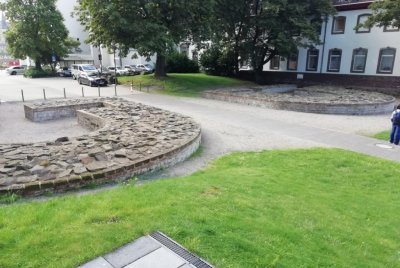
We visited the Köln-Deutz component on a sunny hot September day in 2023 as the Praetorium was (and still is) closed for visitors. A 20 minute walk from Cologne Cathedral across the Hohenzollernbrucke to the eastern bank of the Rhine allows for excellent views of the modern-day cathedral but in Roman times would have had line of sight to the provincial governors palace at the Praetorium. You will have the (admittedly few) remains all to yourself as visitors instead throng the riverfront or city centre. An unexciting 10-15 minutes is the extent of the visit to what are some 1970s reconstructed outlines (using original stones) of one of the gates of the Divittia bridgehead fort, its location in a quiet pedestrian throughway a far cry from being an essential part of Emperor Constantine’s late Roman era defensive line.
There is an information board onsite (fully in German if I recall) and a bronze model up some steps that we missed. Far more is actually to be gleaned from the nomination and ICOMOS documents which identifies Köln-Deutz as one of the few components to actually have some above-ground features as well as the only permanent military installation of the Lower German Limes on the right bank of the Rhine, connected by a 400m bridge to the colony that is now Cologne. Forts of the Late Roman period are characterised by heavy stone walls and large numbers of round towers, of which Köln-Deutz is the best preserved example and seemingly a …
Keep reading 0 comments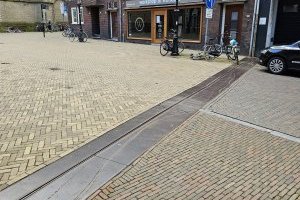
I visited in April 2024 the DOMunder experience in Utrecht. Like previous reviewer has explained, you get to go under the Domplein square to explore with flashlights the ruins of the Dom Church's nave that was destroyed by a tornado(!) in 1647. However, besides the church ruins you can see also other ruins from different time periods, one of them being the Roman period. There is a very tiny part of the Roman wall on show as the Roman ruins are not the main focus of the DOMunder.
The DOMunder tour started with a presentation in the basement of Utrecht Music School where the guide goes through also the Roman history of the Domplein. And here you can get really close to the actual Roman wall ruins! Before the presentation started our guide showed us a hole in the wall where you can see and touch the original Roman wall. This is not automatically part of the tour so you can ask from your guide to see it in case they forget to show it. I really enjoyed the DOMunder experience and can recommend it for anyone interested in history.
I booked the tour online and checked in for it at the Utrecht tourist information center. From the tourist info I got myself a free brochure about the Lower German Limes sites around Utrecht. They all seem to be worth of visit if you're interested in Roman history but the DOMunder is the only way to see the …
Keep reading 0 comments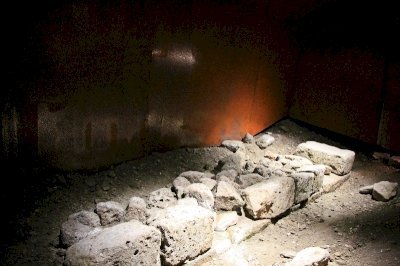
I visited the Lower German Limes in Germany and the Netherlands. The “Roman Disneyland” Xanten is already covered in other reviews. The museum in Cologne was in September still under reconstruction. Therefore I will focus my review on the Netherlands.
In my quest to find original remains in the Netherland. While most of the dots on our map seem to scatter around Nijmegen, it seems that none of these remains are actually visible. Then I stumbled upon Utrecht. Most (if not all) remains in the Netherlands are underground and in Utrecht you have the chance to go there. "DOM under" provides a guided tour to, you guessed it, an excavation site under the cathedral, or rather the part of the main square, that used to be part of the cathedral before a storm struck it down.
Space down there is limited. So you need to pre-book for a timeslot. We started in the basement of a house. There are a few exhibition items and the briefing took place there. Most important: there are remains of the roman walls visible within the building structure. For the second part, we left the building and entered the excavation site via stairs in the middle of the square. The Roman remains are only part of what I saw underground. There are several layers with part of the earliest church and the destroyed cathedral as well. However, there are Roman remains, which makes the Limes in the Netherlands not completely invisible.
…
Keep reading 0 comments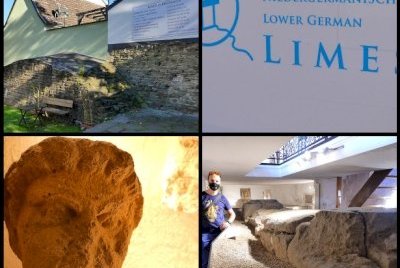
I visited the Lower German Limes WHS location of Remagen in Germany in October 2021 which was one of the only open sites during the pandemic. Basically this WHS is all about scattered Roman remains or ruins so I wasn't expecting much, even though it has to be said that Remagen has a good network of several types of Roman remains or ruins which make for a pleasant loop near the Rhine with 15 stops named Stadtrundgang with information boards in English and German at each stop. The Roman Museum only has information boards in German, but English translations are provided at the entrance.
The "highlight" of this location is the Roman Museum of Remagen with exhibits from the old Roman fort of Rigomagus displayed in the former chapel of St. Magdalena from the 15th century. The collection includes coins and grave contents from the 1st to the 4th centuries AD. Some tombstones with figures of Roman soldiers in full gear are noteworthy. The finds provide an insight into the life of the Roman soldiers based on the Rhine. In the basement of the former chapel you can visit the foundations of an arcade/portico from the 2nd century with 3 large column bases. This portico was the entrance to the "principia", the headquarters of a Roman fort.
The ancient author Ammianus Marcellinus mentions Remagen in his report on the invasion of the Franks in 356. The Roman army under Emperor Julian found the forts and towns between Koblenz …
Keep reading 0 comments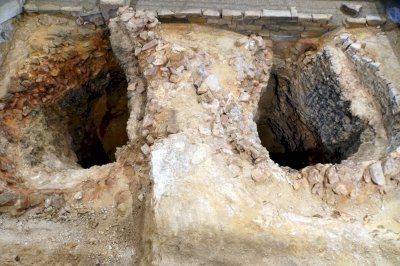
The nomination of the Lower German Limes is scheduled for 2021. The German part of this TWHS includes 25 components, some of which have multiple locations. However, not much is left of the Limes section along the Lower Rhine today, only very few original remains are visible, most remains have been preserved underground. Hence it seems more than questionable whether the Lower German Limes could add anything significant to the already inscribed parts of the Frontiers of the Roman Empire.
The Dutch nomination website provides the entire nomination dossier including maps. Based on this information, I have identified the following locations of the German part, where original remains are visible:
- Xanten Colonia Ulpia Traiana (CUT) (id 27), an archaeological park- Monheim Haus Bürgel (id 35), remains of the original walls are visible in walls of the later medieval and modern estate- Cologne Praetorium (id 37), the former Palace of the Roman govenor; remains are shown in an underground museum- Iversheim (id 43), remains of six lime kilns
I visited Xanten and Iversheim in summer 2020. The Praetorium in Cologne was closed due to construction works (until 2021), the area is being redesigned into an archaeological zone. And the Haus Bürgel didn’t seem worth the detour.
Xanten was once one of the largest and most important Roman settlements in the Germanic provinces. The archaeological park encompasses the boundaries of the historic Colonia Ulpia Traiana. It is a large but almost empty area. Near the main entrance, …
Keep reading 0 comments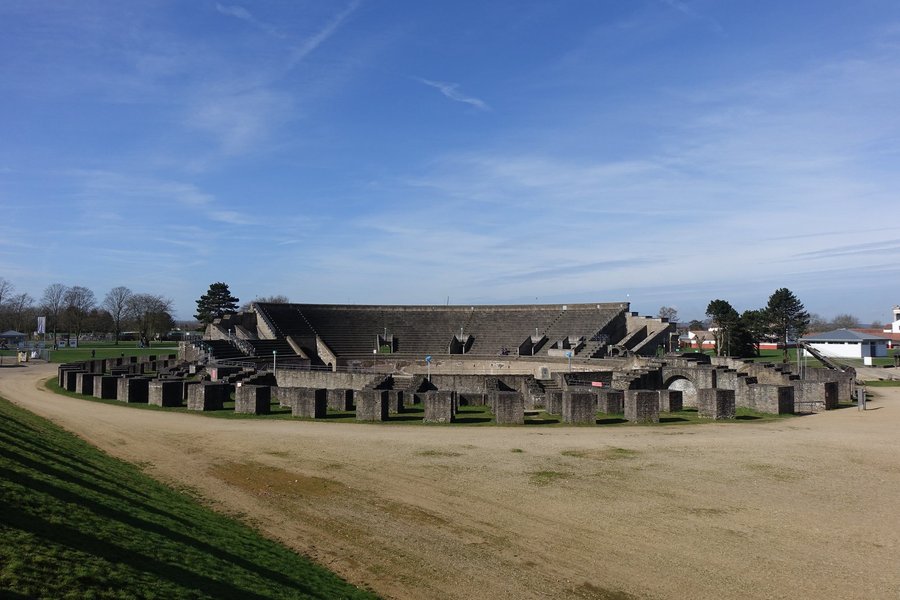
Frontiers of the Roman Empire - Lower German Limes, together with the Dutch Limes TWHS, is scheduled to be nominated in 2021. Together they form the 3rd of 4 clusters of separate stretches of the Roman frontiers up for inclusion, after the already inscribed UK/German one, plus the ‘western Danube Limes’ (2019) and before the ‘eastern Danube Limes’ (2022). The Lower German Limes is concentrated along the river Rhine, which acted as a natural border of the Roman province of Germania Inferior.
I had ‘been’ to its Dutch counterpart already in 2011, which was a very underwhelming experience. Both Lower German parts together are said to comprise 55 locations. Among the locations in Germany, it’s hard to say which stand out so much that they warrant a visit. I chose Xanten, which is home to 4 of the locations ánd has a well-developed archaeological park plus Roman museum within its borders.
Xanten is a mid-sized town just across the Dutch/German border near Nijmegen. In Roman times, it was the site of the Roman city of Colonia Ulpia Traiana. The proposed locations include a road, a defensive structure, the late Roman fortress Tricensima and the legionary fortress Vetera. The tentative site description at the UNESCO website puts them somewhere off the coast of Somalia, but by turning the coordinates around I could trace them back to modern-day Xanten. At least Tricensima is part of the Roman archaeological park, the others may be slightly outside.
The Xanten Archaeological Park is a large, …
Keep reading 0 comments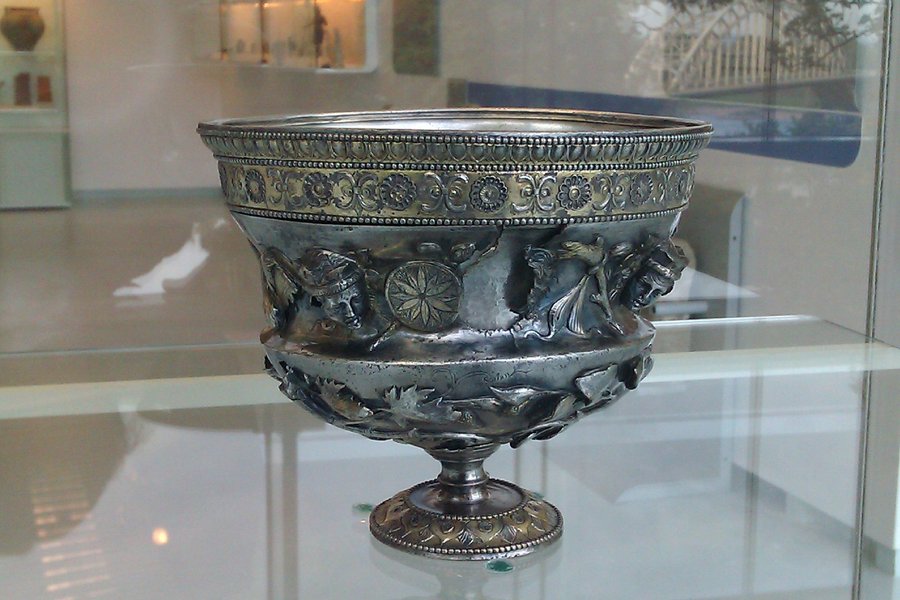
The Dutch T-List nomination for an extension of the Frontiers of the Roman Empire has come as a surprise to me:
a. The Advisory Committee had concluded in 2010 that there was no coordination between the provinces and cities along the former Roman frontier line in the Netherlands on this subject. So there was insufficient steering and power behind a possible nomination.
b. There is nothing left to see!
The Romans arrived around 15 B.C. in what is now The Netherlands, and stayed intermittently for some 300 years. They constructed a number of fortifications along the Rhine river. Roman objects have been found in the moist ground along the river, and sometimes they even have been fished from the water.
The Roman remains in the Netherlands have the obscurity of the Pile Dwellings in the Alps or the Struve Geodetic Arc. Except for a single stone or two, there's nothing to warrant a visit. Museum Het Valkhof in Nijmegen probably is the best option to get a feel of what impact the Romans had on the Netherlands. In October 2011 I spent about an hour there, enjoying the sometimes surprisingly precious objects. The photo attached for example is a decorated silver Roman beaker.
Keep reading 0 comments
Visited the site and was not impressed...
I really wonder why this site is on the tentative list of Unesco World Heritage... Must say that the site is important to Dutch archaeology/history/heritage, but this site does not have a significance for world heritage. A backwater Roman settlement of which hardly anything remains?? The submission text claims "the remains ... are extremely well preserved"; for Dutch standards: yes. For European standards: NO!
Keep reading 0 comments
